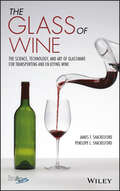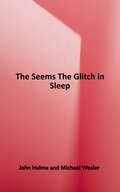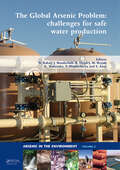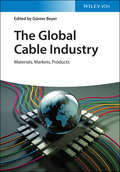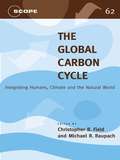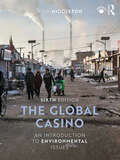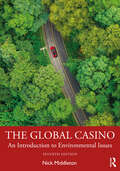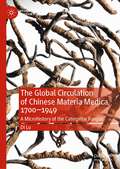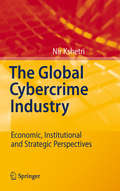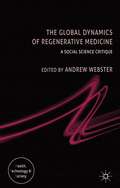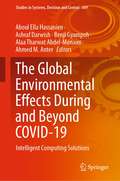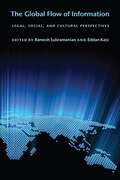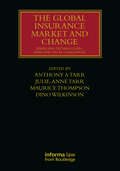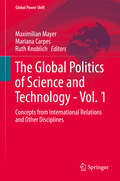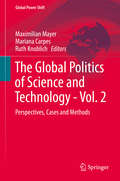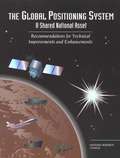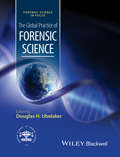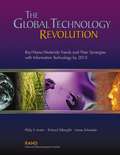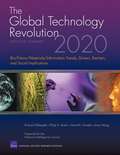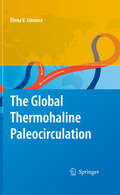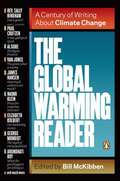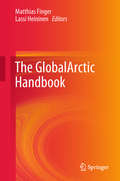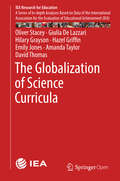- Table View
- List View
The Glass of Wine: The Science, Technology, and Art of Glassware for Transporting and Enjoying Wine
by James F. Shackelford Penelope L. ShackelfordThe first book to focus on the role of glass as a material of critical importance to the wine industry For centuries glass has been the material of choice for storing, shipping, and sipping wine. How did that come to pass, and why? To what extent have glassmaking and wine making co-evolved over the centuries? The first book to focus on the role of glass as a material of critical importance to the wine industry, The Glass of Wine answers these and other fascinating questions. The authors deftly interweave compelling historical, technical, and esthetic narratives in their exploration of glass as the vessel of choice for holding, storing, and consuming wine. They discuss the traditions informing the shapes and sizes of wine bottles and wine glasses, and they demystify the selection of the "right glass" for red versus white varietals, as well as sparkling and dessert wines. In addition, they review the technology of modern glassmaking and consider the various roles glass plays in wineries—especially in the enologist's laboratory. And they consider the increasing use of aluminum and polymer containers and its potential impact on the central role of glass as the essential material for wine appreciation. The first book focusing on the role of glass and its central importance to the wine industry Written by a glass scientist at UC Davis, home of the premier viticulture and enology program in North America Interlards discussions of the multi-billion-dollar glass and wine industries with valuable technical insights for scientists, engineers, and wine enthusiasts alike Illustrates the wide spectrum of bottles, carafes, decanters, and drinking glasses with an abundance of exquisite full-color photos Both an authoritative guide and a compelling read, The Glass of Wine tells the story of the centuries-old marriage between an endlessly fascinating material and a celebrated beverage. It is sure to have enormous appeal among ceramic and glass professionals, wine makers, and oenophiles of all backgrounds.
The Glitch In Sleep (The\seems Ser.)
by John Hulme Michael WexlerWhen twelve-year-old Becker Drane is recruited by The Seems, a parallel universe that runs everything in The World, he must fix a disastrous glitch in the Department of Sleep that threatens the ability of everyone to ever fall asleep again.
The Global Arsenic Problem: Challenges for Safe Water Production (Arsenic in the environment)
by Jochen Bundschuh Prosun Bhattacharya Marek Bryjak Nalan Kabay Bruce Hendry Kazuharu Yoshizuka Suer AnacA prevalent and increasingly important issue, arsenic removal continues to be one of the most important areas of water treatment. Conventional treatment plants may employ several methods for removing arsenic from water. Commonly used processes include oxidation, sedimentation, coagulation and filtration, lime treatment, adsorption onto sorptiv
The Global Cable Industry: Materials, Markets, Products
by Günter BeyerA comprehensive guide to cable materials, markets, and products The Global Cable Industry presents a comprehensive overview of the most recent developments in automotive cables, nuclear power station cables, undersea cables, coaxial cables, optical wires, medium- and high-voltage cables. With contributions from noted researchers and developers in the field, the book includes information on material developments for polymers, crosslinked elastomers and flame retardant non-halogen cable compounds. The contributors provide information on technologies to crosslink polymers, an overview of foam polymers, and field experiences of the new cable fire test within the Construction Product Regulation framework. In addition, this comprehensive resource contains the most relevant economic questions related to the cable industry that highlights materials, market segments, and countries. This important book: Includes contributions from researchers and developers of key companies in the cable industry Presents information on the most recent developments in the field Covers the most industry-relevant cable types such as automotive, nuclear power cables, undersea, coaxial, optical, medium- and high-voltage cables Written for power engineers, materials scientists, chemists and engineering scientists in industry, The Global Cable Industry is an up-to-date guide to the multi-billion-dollar cable enterprise.
The Global Carbon Cycle: Integrating Humans, Climate, and the Natural World (SCOPE Series #62)
by Christopher B. Field Michael R. Raupach Susan Hill MackenzieWhile a number of gases are implicated in global warming, carbon dioxide is the most important contributor, and in one sense the entire phenomena can be seen as a human-induced perturbation of the carbon cycle. The Global Carbon Cycle offers a scientific assessment of the state of current knowledge of the carbon cycle by the world's leading scientists sponsored by SCOPE and the Global Carbon Project, and other international partners. It gives an introductory over-view of the carbon cycle, with multidisciplinary contributions covering biological, physical, and social science aspects. Included are 29 chapters covering topics including: an assessment of carbon-climate-human interactions; a portfolio of carbon management options; spatial and temporal distribution of sources and sinks of carbon dioxide; socio-economic driving forces of emissions scenarios. Throughout, contributors emphasize that all parts of the carbon cycle are interrelated, and only by developing a framework that considers the full set of feedbacks will we be able to achieve a thorough understanding and develop effective management strategies. The Global Carbon Cycle edited by Christopher B. Field and Michael R. Raupach is part of the Rapid Assessment Publication series produced by the Scientific Committee on Problems of the Environment (SCOPE), in an effort to quickly disseminate the collective knowledge of the world's leading experts on topics of pressing environmental concern.
The Global Casino: An Introduction to Environmental Issues
by Nick MiddletonThe Global Casino is an introduction to environmental issues which deals both with the workings of the physical environment and with the political, economic and social frameworks in which the issues occur. Using examples from all over the world, the book highlights the underlying causes behind environmental problems, the human actions which have made them issues, and the hopes for solutions. It is a book about the human impact on the environment and the ways in which the natural environment impacts human society. The sixth edition has been fully revised and updated throughout, with new case studies, figures, and online resources including a complete lecture course for tutors and multiple-choice questions for students. New concepts and topics covered for the first time in this edition include the green economy, the forest transition model, marine microplastic pollution, urban disasters, decommissioning of big dams, and the start of the Anthropocene. Recent international initiatives covered include the Paris Agreement on climate change, the Aichi Biodiversity Targets, and the Sendai Framework for managing disaster risk. New case studies include Morocco’s Noor concentrated solar power plant, desert recovery in Kuwait, and river management on the Huang Ho. Eighteen chapters on key issues follow three initial chapters which outline the background contexts of the physical and human environments and the concept of sustainable development. Each chapter provides historical context for key issues, outlines why they have arisen, and highlights areas of controversy and uncertainty to appraise how issues can be resolved both technically and in political and economic frameworks. Each chapter also contains an updated critical guide to further reading – many of them open access – and websites, as well as discussion points and essay questions. The text can be read in its entirety or individual chapters adopted as standalone reading. This book is an essential resource for students of the environment, geography, earth sciences and development studies. It provides comprehensive and inspirational coverage of all the major global environmental issues of the day in a style that is clear and critical.
The Global Casino: An Introduction to Environmental Issues
by Nick MiddletonThe Global Casino is an introduction to environmental issues which deals both with the workings of the physical environment and the political, economic and social frameworks in which the issues occur. Using examples from all over the world, the book highlights the underlying causes behind environmental problems, the human actions which have made them issues and the hopes for solutions. It is a book about the human impact on the environment and the ways in which the natural environment impacts human society.The seventh edition has been fully revised and updated throughout, with new case studies, figures and online resources comprising a complete lecture course for tutors and multiple-choice questions for students. New concepts and topics covered for the first time in this edition include the blue economy, marine heatwaves, Africa’s Great Green Wall, rewilding, net-zero commitments, nature-based solutions, emerging contaminants in global rivers, green infrastructure in sustainable cities, initiatives promoting zero-emission vehicles, and zoonotic diseases (including the COVID-19 pandemic). New case studies include gender impact assessment of big dams in Laos and Vietnam, reducing food loss and waste, liming sugar maple trees in North America to counteract soil acidification and soil erosion and poverty in Rwanda. Eighteen chapters on key issues follow three initial chapters which outline the background contexts of the physical and human environments and the concept of sustainable development. Each chapter provides historical context for key issues, outlines why they have arisen and highlights areas of controversy and uncertainty to appraise how issues can be resolved both technically and in political and economic frameworks. Each chapter also contains an updated critical guide to further reading—most of them open access—and websites, talks and podcasts, as well as discussion points and essay questions. The text can be read in its entirety or individual chapters adopted as standalone reading.This book is an essential resource for students of the environment, geography, development studies and earth sciences. It provides comprehensive and inspirational coverage of all the major global environmental issues of the day in a style that is clear, concise and critical.
The Global Circulation of Chinese Materia Medica, 1700–1949: A Microhistory of the Caterpillar Fungus (Medicine and Biomedical Sciences in Modern History)
by Di LuThis book explores the dissemination of knowledge around Chinese medicinal substances from the eighteenth to twentieth centuries in a global context. The author presents a microhistory of the caterpillar fungus, a natural, medicinal substance initially used by Tibetans no later than the fifteenth century and later assimilated into Chinese materia medica from the eighteenth century onwards. Tracing the transmission of the caterpillar fungus from China to France, Britain, Russia and Japan, the book investigates the tensions that existed between prevailing Chinese knowledge and new European ideas about the caterpillar fungus. Emerging in eighteenth and nineteenth-century Europe, these ideas eventually reached communities of scientists, physicians and other intellectuals in Japan and China. Seeking to examine why the caterpillar fungus engaged the attention of so many scientific communities across the globe, the author offers a transnational perspective on the making of modern European natural history and Chinese materia medica.
The Global Cybercrime Industry
by Nir KshetriThis book is about the global cybercrime industry, which according to some estimates, is a US$1 trillion industry and is growing rapidly. It examines economic and institutional processes in the cybercrime industry, provides insights into the entrepreneurial aspect of firms engaged in cyber-criminal activities, takes a close look at cybercrime business models, explains the global variation in the pattern of cybercrimes and seeks to understand threats and countermeasures taken by key actors in this industry. This book's distinguishing features include the newness, importance, controversiality and complexity of the topic; cross-disciplinary focus, orientation and scope; theory-based but practical and accessible to the wider audience; and illustration of various qualitative and quantitative aspects of the global cybercrime industry.
The Global Dynamics of Regenerative Medicine
by Andrew WebsterRegenerative medicine, encompassing stem cells and tissue engineering, has attracted huge interest within commercial, clinical and government circles, and promises to change medicine itself. This book provides the first detailed examination and critical assessment of the field to be made by social science.
The Global Environmental Effects During and Beyond COVID-19: Intelligent Computing Solutions (Studies in Systems, Decision and Control #369)
by Ashraf Darwish Aboul Ella Hassanien Benji Gyampoh Alaa Tharwat Abdel-Monaim Ahmed M. AnterThis book aims through 11 chapters discussing the problems and challenges and some future research points from the recent technologies point of view such as artificial intelligence and the Internet of things (IoT) that can help the environment and healthcare sectors reducing COVID-19.
The Global Flow of Information: Legal, Social, and Cultural Perspectives (Ex Machina: Law, Technology, and Society #5)
by Ramesh Subramanian Eddan KartzThe Internet has been integral to the globalization of a range of goods and production, from intellectual property and scientific research to political discourse and cultural symbols. Yet the ease with which it allows information to flow at a global level presents enormous regulatory challenges. Understanding if, when, and how the law should regulate online, international flows of information requires a firm grasp of past, present, and future patterns of information flow, and their political, economic, social, and cultural consequences.In The Global Flow of Information, specialists from law, economics, public policy, international studies, and other disciplines probe the issues that lie at the intersection of globalization, law, and technology, and pay particular attention to the wider contextual question of Internet regulation in a globalized world. While individual essays examine everything from the pharmaceutical industry to television to “information warfare” against suspected enemies of the state, all contributors address the fundamental question of whether or not the flow of information across national borders can be controlled, and what role the law should play in regulating global information flows.Contributors: Frederick M. Abbott, C. Edwin Baker, Jack M. Balkin, Dan L. Burk, Miguel Angel Centeno, Dorothy E. Denning, James Der Derian, Daniel W. Drezner, Jeremy M. Kaplan, Eddan Katz, Stanley N. Katz, Lawrence Liang, Eli Noam, John G. Palfrey, Jr., Victoria Reyes, and Ramesh Subramanian
The Global Insurance Market and Change: Emerging Technologies, Risks and Legal Challenges (Lloyd's Insurance Law Library)
by Anthony A Tarr, Julie-Anne Tarr, Maurice Thompson and Dino WilkinsonThis book focuses on the global landscape in which insurance is transacted, and where it is evolving, driven from within by transformative technologies and externally by the necessity to address risks like climate change and health crises, such as the COVID-19 pandemic. It discusses the dynamic challenges and opportunities that lie ahead for the industry in areas such as on-demand insurance, embedded insurance, parametric insurance, autonomous vehicles, the rise of fintech, the cyber risk landscape and through initiatives driven by distributed ledger technology or blockchain solutions. Moreover, it covers the major external challenges confronting the global insurance market, such as the growing insurance protection gap in relation to the affordability and insurability of natural catastrophes and climate change, and pandemics like COVID-19. This book examines innovations in insurance driven by the industry as well as externally imposed changes and dynamics impacting the industry. It describes these changes, the industry’s responses and the legal framework in which they occur. It canvasses additional regulatory and law reform initiatives that may be necessary to achieve an effective balance between the various competing interests. The book is the first to address these matters holistically with a particular focus upon insurance law, it will describe these changes and industry responses and the legal framework in which they occur. The Global Insurance Market will be directly relevant to legal professionals, insurers, insurtechs, fintechs, brokers, CEOs of insurance companies, risk managers, legal counsel, academics, researchers, the judiciary, and policy makers. It will also serve as a valuable resource for students of all levels.
The Global Movement and Tracking of Chemical Manufacturing Equipment: A Workshop Summary
by Kathryn HughesDual-use applications for chemical manufacturing equipment have been recognized as a concern for many years, and export-control regulations worldwide are in place as a result. These regulations, in conjunction with the verification and inspection requirements of Article VI of the Chemical Weapons Convention, are designed to support non-proliferation of manufacturing equipment suitable for production of chemical warfare agents. In recent years, globalization has changed the distribution of chemical manufacturing facilities around the world. This has increased the burden on current inspection regimes, and increased the amount of manufacturing equipment available around the world. Movement of that equipment, both domestically and as part of international trade, has increased to accommodate these market shifts. To better understand the movement and tracking of chemical manufacturing equipment of dual-use concern, the Project on Advanced Systems and Concepts for Countering Weapons of Mass Destruction at the Naval Postgraduate School contracted with the Board on Chemical Sciences and Technology of the National Research Council to hold a workshop on the global movement and tracking of chemical manufacturing equipment. The workshop, held in May 2014, looked at key concerns regarding the availability and movement of equipment for chemical manufacturing, particularly used and decommissioned equipment that is of potential dual-use concern. The workshop examined today's industrial, security, and political contexts in which these materials are being produced, regulated, and transferred. The workshop also facilitated discussions about current practices, including consideration of their congruence with current technologies and security threats in the global chemical industrial system. "The Global Movement and Tracking of Chemical Manufacturing Equipment" summarizes the presentations and discussion of the event.
The Global Politics of Science and Technology - Vol. 1
by Maximilian Mayer Mariana Carpes Ruth KnoblichAn increasing number of scholars have begun to see science and technology as relevant issues in International Relations (IR), acknowledging the impact of material elements, technical instruments, and scientific practices on international security, statehood, and global governance. This two-volume collection brings the debate about science and technology to the center of International Relations. It shows how integrating science and technology translates into novel analytical frameworks, conceptual approaches and empirical puzzles, and thereby offers a state-of-the-art review of various methodological and theoretical ways in which sciences and technologies matter for the study of international affairs and world politics. The authors not only offer a set of practical examples of research frameworks for experts and students alike, but also propose a conceptual space for interdisciplinary learning in order to improve our understanding of the global politics of science and technology. This first volume summarizes various time-tested approaches for studying the global politics of science and technology from an IR perspective. It also provides empirical, theoretical, and conceptual interventions from geography, history, innovation studies, and science and technology studies that indicate ways to enhance and rearticulate IR approaches. In addition, several interviews advance possibilities of multi-disciplinary collaboration.
The Global Politics of Science and Technology - Vol. 2
by Maximilian Mayer Mariana Carpes Ruth KnoblichAn increasing number of scholars have begun to see science and technology as relevant issues in International Relations (IR), acknowledging the impact of material elements, technical instruments, and scientific practices on international security, statehood, and global governance. This two-volume collection brings the debate about science and technology to the center of International Relations. It shows how integrating science and technology translates into novel analytical frameworks, conceptual approaches and empirical puzzles, and thereby offers a state-of-the-art review of various methodological and theoretical ways in which sciences and technologies matter for the study of international affairs and world politics. The authors not only offer a set of practical examples of research frameworks for experts and students alike, but also propose a conceptual space for interdisciplinary learning in order to improve our understanding of the global politics of science and technology.<P><P> The second volume raises a plethora of issue areas, actors, and cases under the umbrella notion techno-politics. Distinguishing between interactional and co-productive perspectives, it outlines a toolbox of analytical frameworks that transcend technological determinism and social constructivism.
The Global Positioning System: Recommendations for Technical Improvements and Enhancements
by Committee on the Future of the Global Positioning SystemThe Global Positioning System (GPS) is a satellite-based navigation system that was originally designed for the U.S. military. However, the number of civilian GPS users now exceeds the military users, and many commercial markets have emerged. This book identifies technical improvements that would enhance military, civilian, and commercial use of the GPS. Several technical improvements are recommended that could be made to enhance the overall system performance.
The Global Practice of Forensic Science (Forensic Science in Focus)
by Douglas H. Ubelaker Daniel A. MartellThe Global Practice of Forensic Science presents histories, issues, patterns, and diversity in the applications of international forensic science. Written by 64 experienced and internationally recognized forensic scientists, the volume documents the practice of forensic science in 28 countries from Africa, the Americas, Asia, Australia and Europe. Each country’s chapter explores factors of political history, academic linkages, the influence of individual cases, facility development, types of cases examined, integration within forensic science, recruitment, training, funding, certification, accreditation, quality control, technology, disaster preparedness, legal issues, research and future directions. Aimed at all scholars interested in international forensic science, the volume provides detail on the diverse fields within forensic science and their applications around the world.
The Global Technology Revolution
by Philip S. Anton Richard Silberglitt James SchneiderBeyond the agricultural and industrial revolutions of the past, a globaltechnology revolution is currently changing the world. This book discussesthe broad, multidisciplinary, and synergistic trends in this revolution,including genomics, cloning, biomedical engineering, smart materials, agilemanufacturing, nanofabricated computation devices, and integratedmicrosystems. The revolution's effects on human health may be the most startling as breakthroughs improve both the quality and length of human life.Biotechnology will also enable us to identify, understand, manipulate,improve, and control living organisms (including ourselves). Informationtechnology is already revolutionizing our lives, especially in the developedworld, and is a major enabler of other trends. Materials technology willproduce products, components, and systems that are smaller, smarter,multi-functional, environmentally compatible, more survivable, andcustomizable. In addition, smart materials, agile manufacturing, andnanotechnology will change the way we produce devices and improve theircapabilities. The technology revolution will not be uniform in its effectacross the globe but will play out differently depending on its acceptance,investment, and a variety of issues such as bioethics, privacy, economicdisparity, cultural invasion, and social reactions. There will be no turningback, however, since some societies will avail themselves of the revolution,and globalization will thus change the environment in which each societylives.
The Global Technology Revolution 2020, Executive Summary
by David R. Howell Philip S. Anton Anny Wong Richard SilberglittIn 2020, areas of particular importance for technology trends will include biotechnology, nanotechnology, materials technology, and information technology. The authors of this report assessed a sample of 29 countries across the spectrum of scientific advancement (low to high) with respect to their ability to acquire and implement 16 key technology applications (e.g., cheap solar energy, rural wireless communications, genetically modified crops).
The Global Thermohaline Paleocirculation
by Elena IvanovaOriginally published in Russian in 2006, this is the first English translation of this important book on paleoceanography and paleoclimatology. Its initial publication was followed by a surge of interest in this subject prompting the author to revise and translate her original work. In the book, she successfully summarizes her own research over recent years and compiles an overview of up-to-date knowledge on past ocean circulation. The key topics include: - Modern thermohaline circulation and main stages of its development during the Cenozoic - Methods and proxies of paleoceanographic reconstruction - Variability of the meridional overturning circulation and paleoceanographic events in the North Atlantic during the last climatic cycle - Influence of the global thermohaline circulation on paleoceanographic events in the Eurasian Arctic seas, the Northern Indian Ocean, and the South China Sea - The role of the thermohaline circulation in global teleconnections in the Antarctic, Eurasian Arctic, northern Pacific and low latitudes Indo-Pacific. Comprehensive investigation of hundreds of international publications and her own results, convinced the author that the global thermohaline circulation controls the remote teleconnections on millennial-scale and partly on centennial-scale, while short-term climate signals are mainly transferred by the atmosphere. This revised and extended English edition provides the latest unpublished data, new figures and modeling results. The extensive reference list contains more than 100 publications and 140 new references.
The Global Transformation of Time: 1870-1950
by Vanessa OgleAs railways, steamships, and telegraph communications brought distant places into unprecedented proximity, previously minor discrepancies in local time-telling became a global problem. Vanessa Ogle's chronicle of the struggle to standardize clock times and calendars from 1870 to 1950 highlights the many hurdles that proponents of uniformity faced.
The Global Warming Reader: A Century of Writing About Climate Change
by Bill MckibbenOur most widely respected environmental writer brings together the essential voices on global warming, from its 19th-century discovery to the present. With the rise of extreme weather events worldwide--witness the devastation wrought by Hurricanes Sandy, Irene, and Katrina, and the sustained drought across the American West--global warming has become increasingly difficult to deny. What is happening to our planet? And what can we do about it? The Global Warming Reader provides more than thirty-five answers to these burning questions, from more than one hundred years of engagement with the topic. Here is Elizabeth Kolbert's groundbreaking essay "The Darkening Sea," Michael Crichton's skeptical view of climate change, George Monbiot's biting indictment of those who are really using up the planet's resources, NASA scientist James Hansen's testimony before the U. S. Congress, and clarion calls for action by Al Gore, Arundhati Roy, Naomi Klein, and many others. The Global Warming Reader is a comprehensive resource, expertly edited by someone who lives and breathes this defining issue of our time.
The GlobalArctic Handbook
by Matthias Finger Lassi HeininenThis book offers a systematic and comprehensive introduction to the Arctic in the era of globalization, or as it is referred to here, the ‘GlobalArctic’. It provides an overview of the current status of the Arctic as a result of global change, while also considering the changes in the Arctic that have a global effect. It positions the Arctic within a broad international context, it addresses four main themes are discussed: economics and resources; environment and earth system dynamics; peoples and cultures; and geopolitics and governance. Gathering together expert authors and building on long-term research activities, it serves as a valuable reference for future research endeavors.
The Globalization of Science Curricula (IEA Research for Education #3)
by David Thomas Emily Jones Oliver Stacey Giulia De Lazzari Hilary Grayson Hazel Griffin Amanda TaylorGlobalization is a powerful force with far reaching impacts on education and education policy. The growth of large scale international surveys of student achievement and the increasing role played by intergovernmental agencies in education means that the influence that globalization exerts on education is likely to increase even further in the future. This open access book provides a significant and timely investigation into the impacts that globalization has exerted on science curricula in a diverse range of countries using extensive data sets collected by the IEA between 1995 and 2015. Using a combination of quantitative and qualitative methods, this book considers the extent to which there have been changes to the intended and implemented science curricula in different countries over the last 20 years. Consideration is then given as to whether science curricula are becoming increasingly similar across countries over time. Finally the issue of whether the basis of an international core curriculum can be identified is addressed. Readers will gain a unique insight into the extent to which globalization and large scale international assessments have influenced science curricula in the last 20 years within both the primary and secondary phases.
